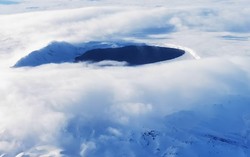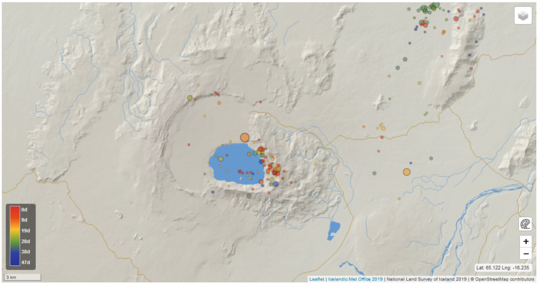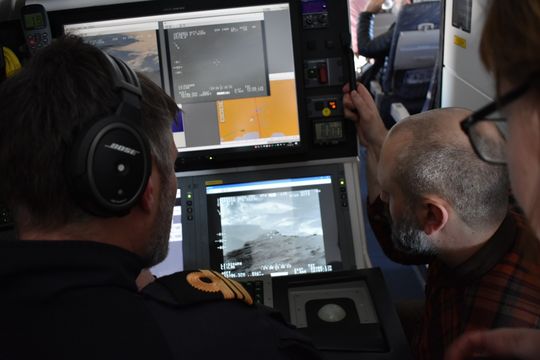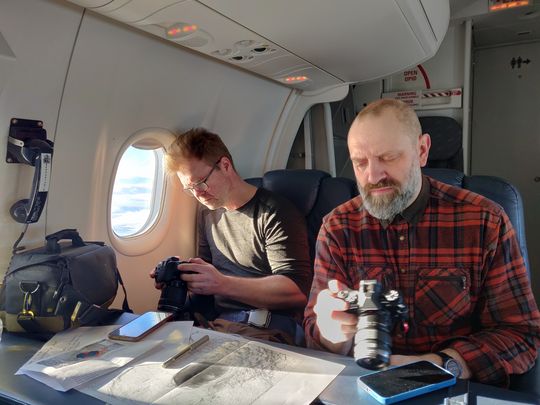No clear signs of an increase in activity at Askja
Seismic activity around Askja increased in August 2021 as uplift, most likely caused by a magmatic intrusion, began. The seismic activity was more elevated in November and December 2021 and has since the start of 2022 remained steady. At the same time, the uplift has continued at a very stable rate since the beginning of the unrest. The number of earthquakes in Askja is like what is considered to be background activity levels in volcanic areas. Most of the earthquakes have been on the eastern edge of Lake Askja and near active geothermal areas but some have occurred outside of the caldera, most notably in November 2019 when a seismic swarm occurred about 6 km east of the caldera ridge.
The uplift can give rise to
earthquakes outside of the immediate area affected by the intrusion as it
changes the surrounding stress field. This may be the case for the recent
earthquake by Herðubreið, but this area frequently experiences earthquakes.
Cumulative number of earthquakes near Askja, size M1,0 or larger, from January 2020-today. This gives an overview of the development of the seismic activity throughout this time of unrest (starting in August 2021) and how it compares with the regular background in the area. The activity was higher in August 2021 and has been steady since then. (Image captured from the earthquake webview of the Icelandic Met Office)
Map showing the locations of earthquakes so far this year. Most of the earthquakes have been on the eastern edge of Lake Askja and near active geothermal areas (Image captured from the earthquake webview of the Icelandic Met Office)
Askja is well monitored
„Askja is one of the volcanoes that we are closely monitoring 24/7“ says Sara Barsotti, coordinator for volcanic hazards at the Icelandic Met Office. „The instruments that we rely on should give us an indication of escalation in the days, and hopefully weeks, prior to an eruption. It is important to keep in mind when it comes to increased volcanic activity that there is most often an interplay between several phenomena, such as an increase of seismic activity as well as a change in the uplift as measured by the GPS network. As the situation is today, there is no clear indication that the activity in Askja is escalating and there is no reason to increase the monitoring above the present levels“, says Sara.
Technicians from the Icelandic Meteorological
Office visited Askja in January to improve the monitoring of the volcano. Maintaining
instruments at Askja and ensuring the continuous transmission of data is
extremely challenging as Askja is in the Icelandic highlands and there is no
cell phone reception inside the caldera. Yesterday a group of scientists from
the Icelandic Meteorological Office and the University of Iceland joined a
flight with the Icelandic Coast Guard aircraft TF-SIF. They flew over Askja where
they were able to better observe the area in the hopes of clarifying the
potential explanation for the unusually early melting of the ice on Lake Askja.
The aircraft´s observation equipment including a camera, thermal camera, and
radar were used to scan the lake and surrounding area. „Nothing unusual came to
light to help explain what is causing the ice to melt,“ says Benedikt G.
Ófeigsson, deformation specialist from the Icelandic Meteorological Office who
was on board the TF-SIF. „No signs of increased geothermal activity were seen
around the lake, nor were there other visible changes which could help clarify
the why the melting is happening,“ says Benedikt.
Ragnar Heiðar Þrastarson and Guðrún Nína Petersen from the Icelandic Meteorological Office together with members of the Icelandic Coast Guard watching the thermal camera mounted on the TF-SIF yesterday. Images from the thermal camera showed infrared energy only at known active geothermal areas around Askja. (Photo: Icelandic Met Office/Esther Hlíðar Jensen)
No measurements made which can explain the melting of the ice on the lake in Askja
An instrument to measure the temperature of the water was dropped into the lake for the scientists from the University of Iceland. This instrument must be collected to learn what it has measured. Different from other bodies of water in the Icelandic highlands, Lake Askja has a persistent hole in the ice that covers it in the winter. This means it is more susceptible to winds being able to grab onto pieces of the ice and mix them into the water. The heat contained in the lake's water is enough to melt the overlying ice. According to the measurements from Upptyppingar, the closest weather station to Askja, in the past month strong winds have been coming from the south. These strong winds may have moved the ice on the surface of Lake Askja, initiating the mixing of ice into the water. It is not possible to exclude an increase in volcanic activity as the explanation for the melting of the ice, but a meteorological explanation is sufficient to explain it.
Two scientists from the Icelandic Meteorological Office, Benedikt G. Ófeigsson and Ragnar Heiðar Þrastarsson, onboard the TF-SIF during an observation overflight yesterday. (Photo: Icelandic Meteorlogical Office/Esther Hlíðar Jensen)








